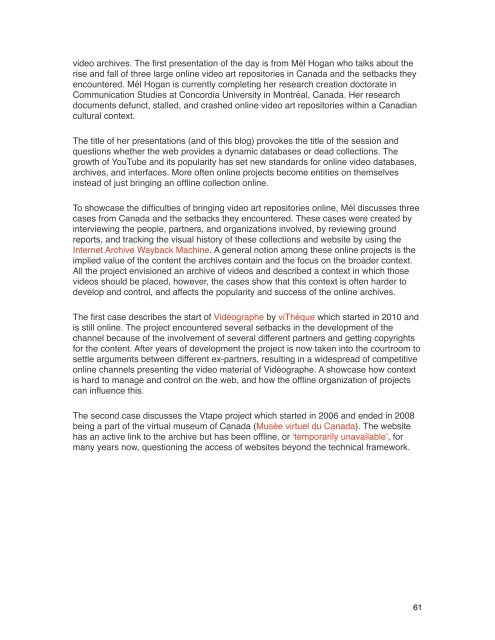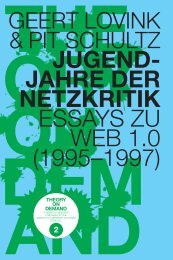Download PDF - Institute of Network Cultures
Download PDF - Institute of Network Cultures
Download PDF - Institute of Network Cultures
You also want an ePaper? Increase the reach of your titles
YUMPU automatically turns print PDFs into web optimized ePapers that Google loves.
video archives. The first presentation <strong>of</strong> the day is from Mél Hogan who talks about the<br />
rise and fall <strong>of</strong> three large online video art repositories in Canada and the setbacks they<br />
encountered. Mél Hogan is currently completing her research creation doctorate in<br />
Communication Studies at Concordia University in Montréal, Canada. Her research<br />
documents defunct, stalled, and crashed online video art repositories within a Canadian<br />
cultural context.<br />
The title <strong>of</strong> her presentations (and <strong>of</strong> this blog) provokes the title <strong>of</strong> the session and<br />
questions whether the web provides a dynamic databases or dead collections. The<br />
growth <strong>of</strong> YouTube and its popularity has set new standards for online video databases,<br />
archives, and interfaces. More <strong>of</strong>ten online projects become entities on themselves<br />
instead <strong>of</strong> just bringing an <strong>of</strong>fline collection online.<br />
To showcase the difficulties <strong>of</strong> bringing video art repositories online, Mél discusses three<br />
cases from Canada and the setbacks they encountered. These cases were created by<br />
interviewing the people, partners, and organizations involved, by reviewing ground<br />
reports, and tracking the visual history <strong>of</strong> these collections and website by using the<br />
Internet Archive Wayback Machine. A general notion among these online projects is the<br />
implied value <strong>of</strong> the content the archives contain and the focus on the broader context.<br />
All the project envisioned an archive <strong>of</strong> videos and described a context in which those<br />
videos should be placed, however, the cases show that this context is <strong>of</strong>ten harder to<br />
develop and control, and affects the popularity and success <strong>of</strong> the online archives.<br />
The first case describes the start <strong>of</strong> Vidéographe by viThèque which started in 2010 and<br />
is still online. The project encountered several setbacks in the development <strong>of</strong> the<br />
channel because <strong>of</strong> the involvement <strong>of</strong> several different partners and getting copyrights<br />
for the content. After years <strong>of</strong> development the project is now taken into the courtroom to<br />
settle arguments between different ex-partners, resulting in a widespread <strong>of</strong> competitive<br />
online channels presenting the video material <strong>of</strong> Vidéographe. A showcase how context<br />
is hard to manage and control on the web, and how the <strong>of</strong>fline organization <strong>of</strong> projects<br />
can influence this.<br />
The second case discusses the Vtape project which started in 2006 and ended in 2008<br />
being a part <strong>of</strong> the virtual museum <strong>of</strong> Canada (Musée virtuel du Canada). The website<br />
has an active link to the archive but has been <strong>of</strong>fline, or ʻtemporarily unavailableʼ, for<br />
many years now, questioning the access <strong>of</strong> websites beyond the technical framework.<br />
61







